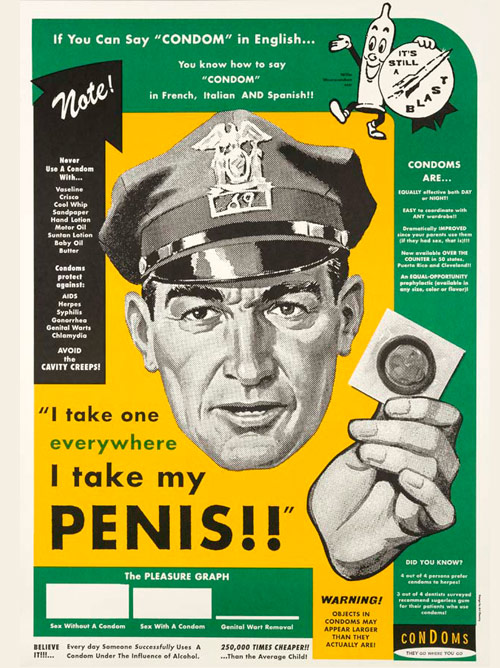aids
AIDS is Not Over
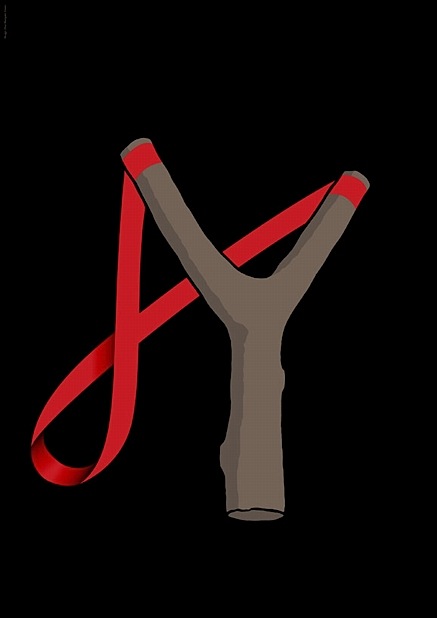
Poster design by Chaz Maviyane-Davies for World AIDS Day.
100 Years of Sex
To commemorate 100 years of public health STD programs, the City Clinic of San Francisco has posted 100 posters on STD prevention. The images lack attribution and date, but the spectrum visual strategies and messages is fantastic.
I thought this one was particularly effective, both earnest and ironic, packing humor and fear in an urgent and familiar retro package:
To really catch all the zingers, click through for an, um, larger version.
Update 7/11/11. Mike wrote in to ID the poster above: it was designed by Art Chantry in 1993. There’s a bit more info on it here.
It’s also one of the 150 images in this exhibition of 25 years of international AIDS awareness posters. Some highlights are up at Design Observer.
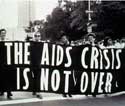 Visual AIDS has posted a small gallery of typographically-driven work from artists with HIV. In context, some of the images are quite devastating. Here’s the curator’s statement.
Visual AIDS has posted a small gallery of typographically-driven work from artists with HIV. In context, some of the images are quite devastating. Here’s the curator’s statement. My Stories
In July 2009, I noted a study concluding that Brazil’s telenovelas have inspired both a drop in birth rate and rise in divorce. Via the Communication Initiative Network, I found a a few other items on soap operas and public health:
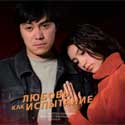
- A German report looks at TV soap operas in Kyrgyzstan, the Dominican Republic, and Côte d’Ivoire as vehicles for HIV/AIDS education.
- A radio soap opera in Vietnam reached millions of farmers changing their attitudes and practices managing rice pests, fertilisers, and seeds.
- Authors of a 2006 paper on a radio soap opera in Bihar, India document how it spurred fundamental, sustainable shifts in people’s values and beliefs.
- A May 2008 Master’s thesis looks at the effect of two Ethiopian radio dramas on attitutde towards reproductive health and spousal abuse.
- Fans of a radio drama in Sudan learned about, or were reinforced in, the importance of abandoning female circumcision, giving girls more control of their reproductive health, having a small family, and staying away from drugs and alcohol.
And though I couldn’t find a study on its impact, straphangers in New York City may remember Julio and Marisol: Decision, an episodic comic strip soap opera dealing with AIDS that ran in English and Spanish in NYC subway cars from 1989 through 2001.

East Village Memorial

This memorial is painted on the side of Mamma’s Food Shop on 6th street and Avenue C. Click the image above for a larger version. The mural is signed by Taboo!, an East Village drag queen. I couldn’t find much about her online except mention (and a photo) in this old Wigstock release.
The piece commemorates a mix of stars, artists, drag queens, and others. Some died of AIDS, others were East Village locals. Some names I recognize, others I do not. Members of a family quietly fading.
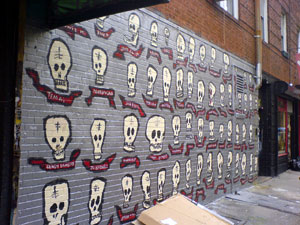
SILENCE = DEATH
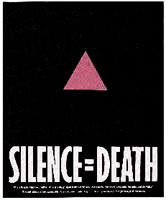 From the Encyclopedia of AIDS:
From the Encyclopedia of AIDS:
“The pink triangle was established as a pro-gay symbol by activists in the United States during the 1970s. Its precedent lay in World War II, when known homosexuals in Nazi concentration camps were forced to wear inverted pink triangle badges as identifiers, much in the same manner that Jews were forced to wear the yellow Star of David. Wearers of the pink triangle were considered at the bottom of the camp social system and subjected to particularly harsh maltreatment and degradation. Thus, the appropriation of the symbol of the pink triangle, usually turned upright rather than inverted, was a conscious attempt to transform a symbol of humiliation into one of solidarity and resistance. By the outset of the AIDS epidemic, it was well-entrenched as a symbol of gay pride and liberation.
In 1987, six gay activists in New York formed the Silence = Death Project and began plastering posters around the city featuring a pink triangle on a black background stating simply ‘SILENCE = DEATH.’ In its manifesto, the Silence = Death Project drew parallels between the Nazi period and the AIDS crisis, declaring that ‘silence about the oppression and annihilation of gay people, then and now, must be broken as a matter of our survival.’ The slogan thus protested both taboos around discussion of safer sex and the unwillingness of some to resist societal injustice and governmental indifference. The six men who created the project later joined the protest group ACT UP and offered the logo to the group, with which it remains closely identified.
Since its introduction, the ‘SILENCE = DEATH’ logo has appeared in a variety of manifestations, including in neon as part of an art display and on a widely worn button. It was also the forerunner of a range of parallel slogans such as ‘ACTION = LIFE’ and ‘IGNORANCE = FEAR’ and an entire genre of protest graphics, most notably including a bloodstained hand on a poster proclaiming that ‘the government has blood on its hands.’ Owing in part to its increasing identification with AIDS, the pink triangle was supplanted in the early 1990s by the rainbow as the dominant image of ‘gay pride.’ By force of analogy, however, the rainbow itself has, in some countries, become an image associated with AIDS.”
via ACT UP NY:
“There was also the SILENCE=DEATH Project, which was a group of men who had started meeting a year and half before [ACT UP was started], including Avram Finklestein, Oliver Smith, and Chris Lione. They were a whole group of men who needed to talk to each other and others about what the fuck were they going to do, being gay men in the age of AIDS?! Several of them were designers of various sorts—graphic designers—and they ended up deciding that they had to start doing wheat-pasting on the streets, to get the message out to people: ‘Why aren’t you doing something?’ So they created the SILENCE=DEATH logo well before ACT UP ever existed, and they made posters before ACT UP ever existed, and the posters at the bottom said something like, ‘What’s really happening in Washington? What’s happening with Reagan and Bush and the Food and Drug Administration?’ It ended with this statement: ‘Turn anger, fear, grief into action.’ Several of these graphic designers were at that first evening that Larry spoke.”
Big ’up to v-2.
HIV / AIDS / WWW
“Each December 1, World AIDS Day, the creative community observes A Day With(out) Art, in memory of all those the AIDS pandemic has taken from us, and in recognition of the many artists, actors, writers, dancers and others who continue to create and live with HIV and AIDS.
A Day With(out) Art was created by the group Visual AIDS in New York City.
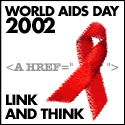 For the last several years, Creative Time has organized a Day With(out) Art observance on the worldwide web, encouraging diverse website designers and administrators to darken their site and convey AIDS prevention and education information to their visitors.
For the last several years, Creative Time has organized a Day With(out) Art observance on the worldwide web, encouraging diverse website designers and administrators to darken their site and convey AIDS prevention and education information to their visitors.
In 1999, more than 50 webloggers took part in a project called a Day With(out) Weblogs. In 2000, nearly 700 personal weblogs and journals of all sorts participated. In 2001, the number was over 1,000. The personal web publishing community — weblogs, journals, diaries, personal websites of every kind — has continued to grow and diversify.
Once again, everyone who produces personal content on the web is invited to participate a global observance of World AIDS Day. In recognition of the variety of sites participating — E/N sites, weblogs, journals, newspages and more — and to differentiate it from other, similar endeavors, a Day With(out) Weblogs became Link and Think.”
Despite the corny name, Link and Think is one of the more effective online grassroots marketing campaigns I’ve seen. While a Day With(out) Weblogs was more of a memorial and show of solidarity, Link and Think also takes a more forward looking view.
Of the Web logs I check regularly, MetaFilter posted decent set of links. The facts, stories, and images are chilling, but it’s also nice to see a bit of perspective — for instance, asking why AIDS dominates the public health debate.
AIDS Memorial Quilt
“In June of 1987, a small group of strangers gathered in a San Francisco storefront to document the lives they feared history would neglect. Their goal was to create a memorial for those who had died of AIDS, and to thereby help people understand the devastating impact of the disease. This meeting of devoted friends and lovers served as the foundation of the NAMES Project AIDS Memorial Quilt. Today the Quilt is a powerful visual reminder of the AIDS pandemic. More than 44,000 individual 3-by-6-foot memorial panels — each one commemorating the life of someone who has died of AIDS — have been sewn together by friends, lovers and family members.”
If you’ve lost someone to AIDS, find out how you can contribute a panel to the Quilt.
page 2 1


